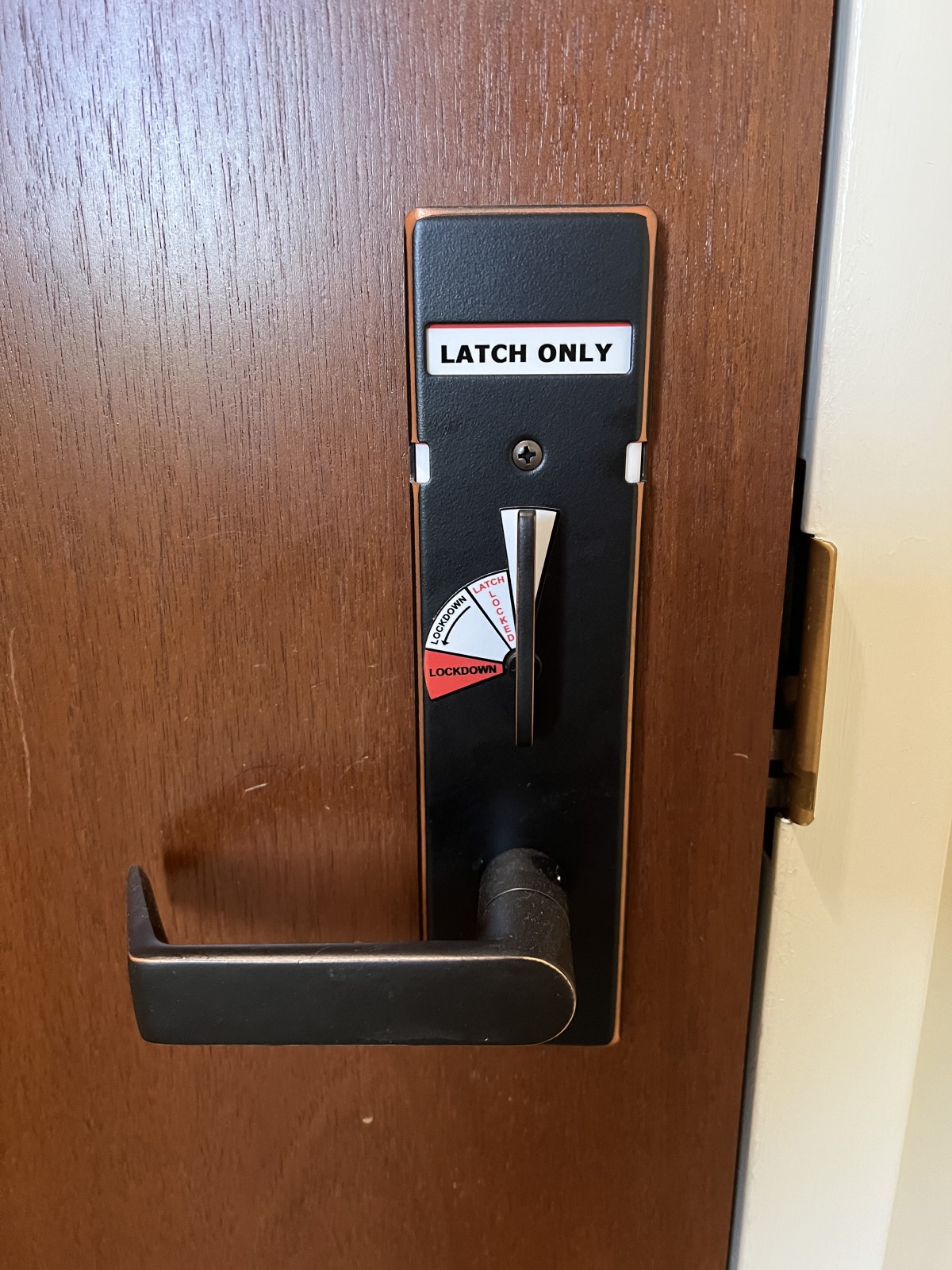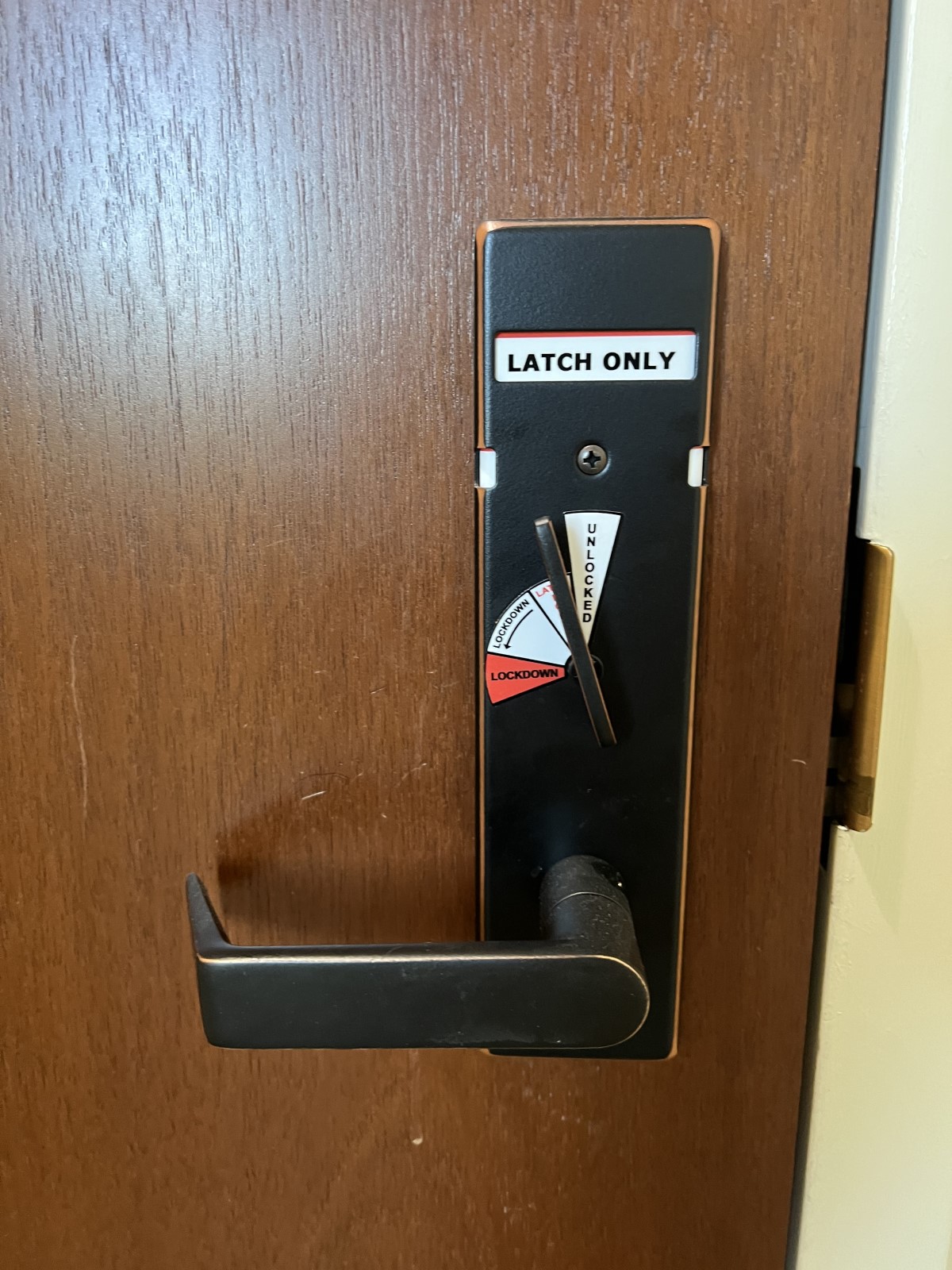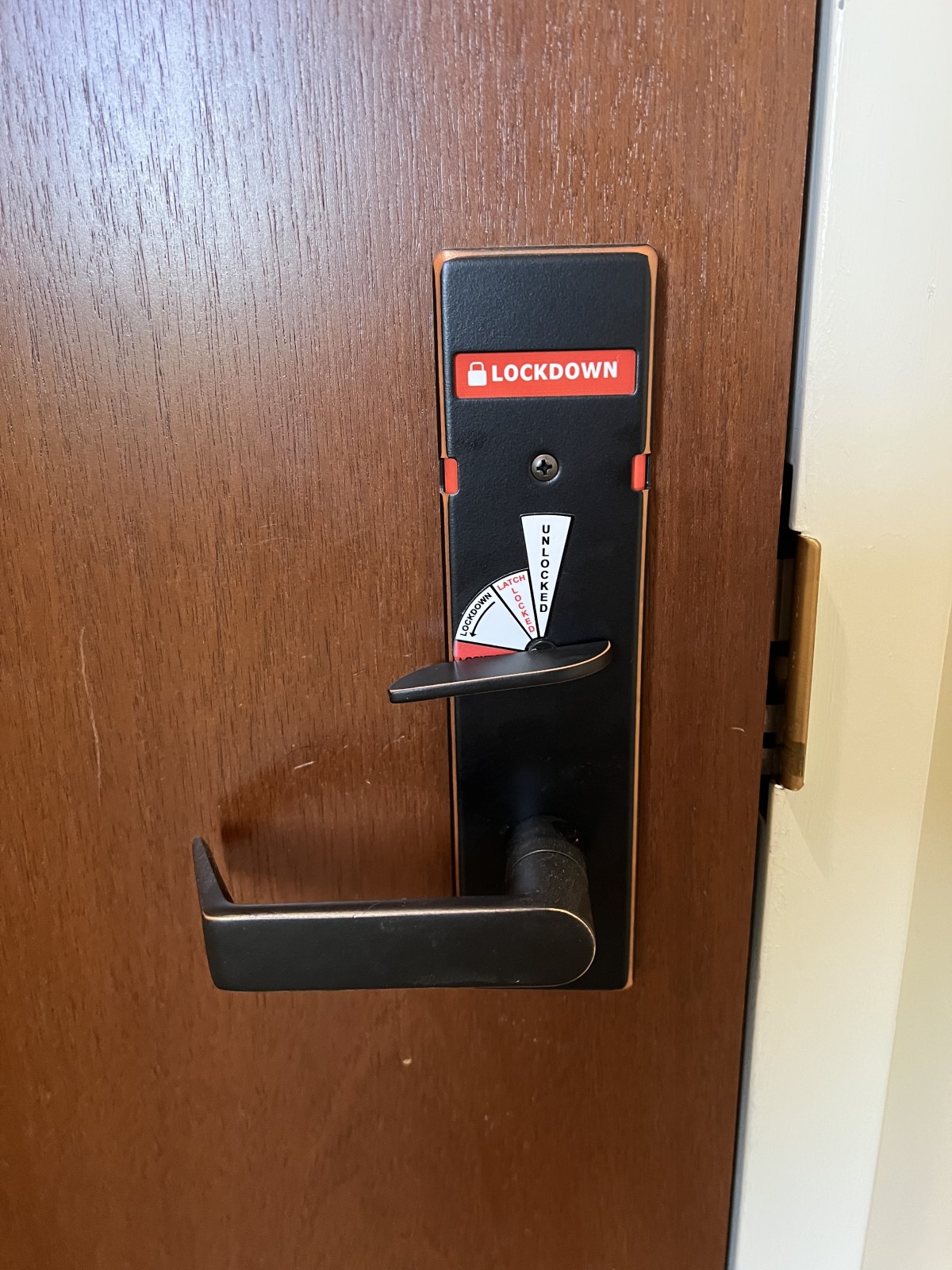I recently received the photos below, taken in a university classroom. The lockset shown here is an entrance/office function with deadbolt (Schlage L9453), and it operates as follows:
- The inside lever always allows free egress.
- The outside lever is locked when the thumbturn is rotated 20 degrees.
- The deadbolt is projected when the thumbturn is rotated 90 degrees.
- Key operation from the outside retracts the deadbolt and latchbolt – outside lever remains locked.
- Rotating the inside lever retracts the deadbolt and latchbolt – outside lever is unlocked when thumbturn is returned to the vertical position.
An added benefit of using this lock function is that an electric strike could be incorporated for access control. In a lockdown condition, the deadbolt could be thrown and captured in the strike, and would prevent access even if someone had the correct card or other electronic credential. A key would be needed in order to access the locked room from the outside.
To help building occupants understand the operation of this lock function and the difference between locking the outside lever with the thumbturn at 20 degrees and throwing the deadbolt at 90 degrees, National Security & Door created the decal shown in the photos, along with the indicator label. There is more information here: Classroom Lockdown System, Indicator File Edit, Indicator Lock Foldable Brochure.
I’m hoping that some iDigHardware readers who work in the educational space will share your thoughts on using this function for classroom doors. WWYD?



Thanks for the photos, Nolan!
You need to login or register to bookmark/favorite this content.









I like the idea but feel a slightly worn down thumb turn will cause issues down the road. If possible I would have the thumb turn go one way for the latch and the other for the latch and deadbolt. Giving even clearer indication to staff, simplicity of function, and less issue with hitting whatever 20 degree sweet spot needed in day to day use.
I like that idea!
– Lori
I’m the one that provided this photo. Here’s some in-the-weeds explanation:
This is how the L-Series mortise lock was designed back in the 1980s. This L9453 lock is the ANSI F20 function, which most other brands call the “Apartment” function.
Almost all other mortise locks with this function use a toggle switch or push buttons on the door edge to control the outside lever/knob “latch locked” functionality. Throwing the deadbolt will automatically lock the outside handle, and retracting the deadbolt (or using the inside handle) will open the door, but won’t unlock the outside handle. You must use the toggle EACH TIME to do so – throwing the deadbolt automatically puts the toggle back into the locked state.
This “locked by default” design of the F20 function provides greater security, but as you can imagine, this leads to many lockouts for people that don’t understand how the toggle works and walk out without taking their key, or forget to flip it back to the unlocked position. This is a particular problem with high tenant turnover in apartment/condo buildings, which often use mortise locks with the F20 function (though a lot of newer buildings use electronic locks).
The L-Series thumbturn design tries to help solve this problem while keeping lock functionality the same – if you turn the thumbturn ALL THE WAY clockwise to 0º (in this example, with a left-hand door) you know that it’s fully unlocked from the outside. You can look at the lock and instantly know its state. You don’t have to remember to check the toggle or jiggle the outside handle when you leave. However, if you use the single-motion egress feature to open the door just by turning the handle, the thumbturn will reset to the 20º latch locked position. You must manually turn it to the unlocked position.
Probably the only improvement that would be easy to make without serious internal changes would be a 45º position for “latch locked” as opposed to 20º. The hub is designed for this three-position action with unlocked, latch locked, deadbolt locked in that order – putting the latch locked position on the other side would require more moving parts and be more difficult to develop = higher costs.
Thumbturn wear is not really an issue. These locks have a very audible and tactile “click” when engaging and disengaging the latch locked 20º position. The internal pieces making this happen are incredibly durable. As long as they are not seriously abused, L-Series locks should last upwards of 50 years, with a very occasional lubrication.
Thanks for sharing your insight, Nolan!
– Lori
Ok
The outside lever is locked in the 20 degree,,, “latch locked “ position.,,, But the flag says latch only,,?
Just like in the “”Unlocked”” position???
A little confusing to me. I might look at the flag and think the outside lever is disabled.
Just a thought.
So do you get a walk through of the Las Vegas Sphere, To see the exiting and hardware used?
I noticed that too – I think it’s because the indicator only has 2 positions so it’s not a perfect solution (yet).
I wonder if know anyone who can give me a tour of the Sphere’s egress doors!! I’m reminded of the time I took the kids to Universal Studios and the director of security put the kids on rides (without waiting in line) and took me behind the scenes. The kids weren’t that impressed until we went to Disney a few days later…one of them asked, “Don’t you ‘know’ anyone here, Mom?” 🙂
https://idighardware.com/2012/05/universal-studios-orlando/
– Lori
You have pull
Just flash your door hardware inspector badge.
Just wondering… what happens to the hardware if someone rotates the thumb turn past the “latch locked” position and then leaves it in the white section above the orange “lockdown” section?
This would seem like a good application for a counter balanced spring that would cause the thumb turn to snap all the way into full lockdown once rotated past a certain point.
There actually is no spring that forces the thumbturn to the “lockdown” position if you turn it halfway and leave it in that white section. The deadbolt will become partially (but not fully) projected, outside lever will still remain locked, inside lever will retract the deadbolt but leave the outside lever locked.
The Sargent (how dare I mention that name here) 8200 doesn’t let you do this. Either it’s fully projected or fully retracted.
This is Mark Longest with National Security & Door. I have been with National Security & Door (NSD) for 18 years, and have worked in the industry for over 45. NSD’s focus has always been on “Life Safety, Security & Functionality”.
A little back story or history, our experience with Schlage’s indicator mortise lock predates its use in the classroom security application, back to when its primary use was for occupancy indication. We saw the potential for swapping the indicator from the exterior side of the door to the inside, for use as a lock status indicator for classroom applications. After initially being told it could not be done, we ordered a lock body and an assortment of indicator parts and literally built the lock on the office floor. Knowing it was possible, we went on to propose the use of this lock to an area community college, we got that job and installed over 1000 of them.
The common complaint to the original lock, based upon lock function, was in order to lock the door at the end of day, you would have to lock the door by key from the outside, projecting the deadbolt. This lead to looking at the L9453 function. This application gave the ability to lock the outside lever via thumbturn, and have the door close behind you and be secure. This lock function also gave the added functionality to allow the teacher to have full control of the lock from inside of the classroom, it could be placed in a passage mode to allow students to freely enter the classroom, or placed in the 20 degree or “manual storeroom” position, preventing anyone from entering or disturbing the class, and full extension of the deadbolt positioning the lock into full “Lockdown” mode. The ability to change easily from a passage mode to a storeroom mode, as opposed to just storeroom function also eliminates “door propping”. This lock with the L9453 function, has been used to support classroom lockdown in over 15 schools in one southwest Virginia school system, as well as numerous others including the university referenced above.
The indicator labeling on the locks above are slightly different from Schlage’s standard offering of “Unlock/Locked”. NSD re-labeled the indicator to try to more accurately describe the lock’s condition, “Latch Only” describing the passage mode, turning the thumbturn to the 20 degree position would move the indicator down slightly to reveal a red line at the top indicating the “manual storeroom” mode, and full extension reading “Lockdown”.
Schlage’s newest indicator revision does not support any movement of the indicator in the 20 degree position. Having the indicator in the 20 degree position and read “latch only” is a realistic description, stating that the door is only secured by the latchbolt, as opposed to the accurate description of “Lockdown”, knowing the deadbolt has been thrown. The thumbturn position decal lends to the common user (the teacher) the ability to know the locks current status, and puts control in the users’ hands.
As Lori stated above, it may not be the perfect solution, yet, but the added functionality, and redundancy of the mechanical locking via deadbolt in electric strike applications has worked well for us, and has been embraced by teachers and administrators alike.
Hi Mark –
Thanks so much for the extra info!
– Lori
I wonder how many teachers will just go to full lockdown, normally??